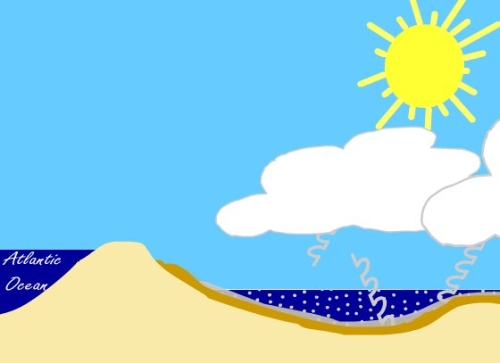
Modeling the Messinian Desiccation
I received funding from the NSF to do climate modeling of the Messinian Desiccation. During this very interesting event about 5.6 million years ago, the Mediterranean Sea very largely evporated, leaving large deposits of salt in its basins, resulting in the erosion of (now buried) canyons by all the major rivers flowing into the Mediterrean, and (perhaps) causing some interesting changes in climate in surrounding regions.
Giant evaporite deposition events like this one (there have been several others over geological time, leaving behind enormous salt deposits in Germany, Oman, and west Texas) are thought to occur when tectonic forces result in the creation of a division between the ocean and a sea which restricts or eliminates the flow of water from the sea to the ocean. The sea needs to be in a region of the world where evaporation exceeds precipitation, so that when the sea is connected to the ocean, inflowing ocean water, in addition to precipitation and river inflow, balances the loss of water from the sea to evaporation. Then the salinity of the sea will increase as its volume decreases, until the saturation point for various salts is exceeded. The present Mediterranean Sea is such a sea: more Atlantic water flows in through the straits of Gibraltar than Mediterranean water flows out.
This sounds simple enough, but there's a problem. Many of these giant salt deposits are very thick. In the case of the Mediterranean, there a couple of kilometers of salt down there. This is much more salt than is dissolved in the whole Mediterranean Sea. In fact, ten times as much ocean water as fills the Mediterranean must have flowed into the basin and evaporated to make all the salt down there. What's the problem? Recent work by Paul Meijjers has shown that even a shallow (10 meter deep) channel, a few kilometers wide, would allow enough water to flow through it to fill up an empty Mediterrean to the brim, dilluting the salt, and preventing any new deposits. So we're stuck with a few possibilities. Perhaps the connection between the Atlantic and the Mediterranean opened and closed several times (perhaps because the global sea level rose and fell). Perhaps the connection between the Mediterranean and the Atlantic was both shallow and very long, so that friction slowed the flow, allowing sea water to flow gradually into the almost basin and evaporate. Another possibility, recently suggested by P.L. Blanc, is that a very shallow connection between the Atlantic and the Mediterranean might have allowed water to flow into the basin, but not out, for a long time, resulting in a basin filled with extremely salty water, before a final cutting of the connection allowed evaporation salt formation. Gianmaria Sannino and I are conducting modeling studies to test this possibility.
My student, Lisa Murphy, and I, with Natalie Mahowald and Bette Otto-Bliesner of NCAR are working on a modeling experiment to determine, among other things, how Mediterranean sea level changes would influence evaporation in the basin (as the sea level goes down we expect it to become more difficult for the atmosphere to remove water from the basin, not only because of the reduction in surface area, and the increase in salinity, but also because the static stability of the desiccating basin should be quite high, reducing upward moisture transport). This will allow a much more sophisticated understanding of physics governing the sea level within the Mediterranean basin during this episode. We've submitted a paper on our modeling results to the journal Palaeogeography, Palaeoclimatology, Palaeoecology.
There's a lot of interesting research being done on the Messinian desiccation, some of which you can find summarized here.
My undergraduate research assistants, Ashley Griffin, Lauren Woolsey, Daniel Kessler, Ben Nehl and I have put together an educational website on the Messinian Desiccation aim at a middle school audience, to whom earth sciences are often taught.
Acknowledgment and Disclaimer
This material is based upon work supported by the National Science Foundation under Grant No. ATM-0457515.
Any opinions, findings and conclusions or recomendations expressed in this material are those of the author(s) and do not necessarily reflect the views of the National Science Foundation (NSF)
